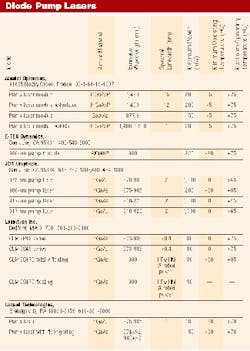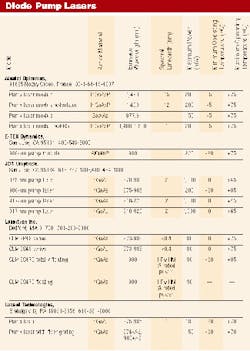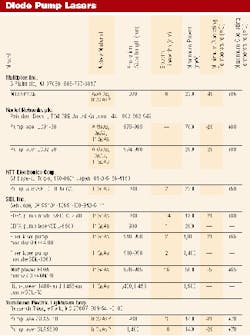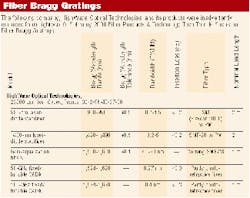Diode pump lasers key to enabling worldwide optical networking
By ROBERT PEASE
The widespread deployment of dense wavelength-division multiplexing (DWDM) systems is a direct result of the development of optical amplifiers, specifically erbium-doped fiber amplifiers (EDFAs). In a 1999 photonics research report by CIBC World Markets Inc. (Toronto, Ontario, Canada), entitled "Pumped Up on the Optical Amplifier Market," it was hypothesized that "absent the advent of the optical amplifier at the University of South Hampton in the United Kingdom, the Internet would have collapsed under its own weight long ago."
But while EDFAs foster a growing worldwide DWDM market, the real credit for enabling the technological advancement of fiber-optic telecommunications should be passed down to the diode pump lasers that make the optical amplifier a reality. According to the CIBC report, 1,480-nm pump lasers were the first to be designed into the amplifiers, as their lower power allowed for heightened reliability, critical to telecommunication network acceptance. Shortly thereafter, higher-power 980-nm pump lasers were introduced by companies like JDS Uniphase (San Jose, CA) and SDL Inc. (San Jose) with life test data demonstrating long-life chips-100-plus years meantime to failure.The market for pump lasers operating at 1,480 nm and 980 nm is expected to explode as the demand for these components reaches unprecedented levels. CIBC predicts the total market for 1,480-nm pump modules, manufactured primarily in Asia, could grow from about $272 million in 1999 to $2.7 billion in 2004. Likewise, the 980-nm pumps, mostly manufactured in North America and Europe, are expected to increase from $109 million in 1999 to $1.7 billion by 2004. Manufacturers, a sampling of which are listed in the accompanying table, are racing to meet a huge demand for diode pump-laser components.
"Market trends point to an explosion in the pumps market," says Gerald Chretien, product marketing director at Alcatel Optronics (Reston, VA). "There is a huge increase of the mass concerning 1,480-nm pumps. The part of 980-nm pumps is increasing more and more and should account for about half the market by 2002."
Undersea fiber-optic systems, a surging market itself, are helping increase the worldwide demand for pump lasers. The higher powers associated with 980-nm pumps are expected to drive a rapid transition from the exclusive use of 1,480-nm pumps in the submarine market to amplifier designs that will use both-similar to what occurred in terrestrial systems. CIBC believes the undersea opportunity could soon rival the terrestrial market in dollars. In a previous report a year earlier, CIBC pegged the undersea opportunity at $288 million for 980-nm chips and $81 million for 1,480-nm chips by 2004. In the latest report, the company believes the combined pump-laser undersea market will likely be much larger than the estimates of just one year ago.
Specific trends are also beginning to emerge for diode pump-laser manufacturers. The increased use of 1,480-nm pumps due to the greater pumping power required for multiple-stage EDFAs will push the consumption of 1,480-nm pumps closer to that of the 980-nm, which currently leads consumption by almost a 2 to 1 ratio. A shift to higher-power pump lasers will result from the increasing number of DWDM channels being deployed and as the gain and output power of EDFAs continue to increase. Raman amplifiers just emerging in the market are expected to make a big splash in the amplifier market."Raman amplifiers have a certain characteristic that basically provides amplification in a wavelength band approximately 100 nm higher than the pump wavelength," explains Ed Miskovic, marketing director for the electro-optics product division at Sumitomo Electric Lightwave (Vancouver, WA). "For example, if a 1,480-nm laser is used to pump the amplifier, the amplifier will experience gain in the 1,580-nm wavelength region. Careful combinations of pump wavelength and power can obtain a wide and relatively flat wavelength gain band. However, Raman amplifiers require high pump powers, pushing the demand for increased power to the pumps. Typically, pumps for Raman amplifiers have output powers in the 250-mW to 750-mW range. Presently, this is accomplished through a combination of high-power pumps and multiplexing techniques."
The need for lower-power, uncooled pumps is a growing trend for the metropolitan market. EDFAs designed for use in the metropolitan area require less cooling functionality and lower power for shorter distances. Most pumps on the market are rather expensive when compared to the requirements of this market, so opportunities exist for less expensive, low-power, uncooled pump lasers with a typical power output of 30-40 mW into a singlemode fiber.
This market is expected to increase rapidly and spur more competition among manufacturers.
Several pump lasers can also reside inside one optical amplifier. By 2004, CIBC expects average pumps per high-powered amplifier to more than double to roughly eight, an average combination of 3.5 980-nm pumps and 4.5 1,480-nm pumps. Beyond eight pumps, amplifier design becomes increasingly complex; the trend will likely be toward higher-power chips, providing more milliwatts per module, to boost amplifier power.
"The 1,480-nm market is a competitive market with numerous manufacturers," says Alcatel's Chretien. "On the contrary, the 980-nm market is not very competitive, with most of the market shared by SDL and JDS Uniphase."
Chretien's observations are substantiated by the CIBC report. The barriers to entering the 980-nm pump-laser manufacturing market are extremely high-higher, in fact, than for any other optical component. The most significant hurdle is probably the thousands of hours of laboratory and field tests that SDL and JDS Uniphase have under their respective belts, proving their lasers meet network operators' stringent terrestrial and undersea requirements.
A second key barrier is power requirements. As DWDM system original equipment manufacturers move to higher channel-count systems, they continuously demand higher-power pump lasers. The fact that power and reliability are inversely related makes for a very steep learning curve, leaving other competitors continually playing catch-up.
The 1,480-nm pump market may be slightly easier to enter since the components are somewhat easier to manufacture. However, there are still significant barriers to entry, particularly as manufacturers move to boost powers above 200 mW.Although there are limited players competing in the diode pump-laser market, there are still plenty of differentiators. New technologies are running rampant in the optical amplifier arena and the manufacturers are under constant pressure to adjust to market demands-higher power, lower power, more cooling, less cooling, and the ever-present lower cost. When all is said and done, these small components are still a centerpiece of fiber-optic networks over the land and across the seas.



